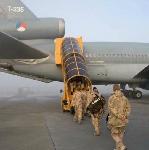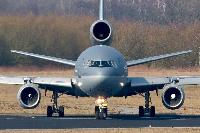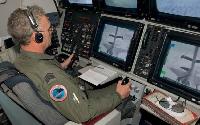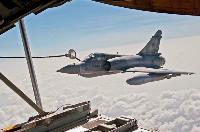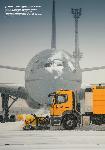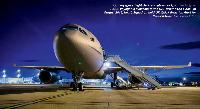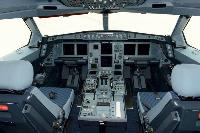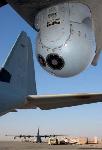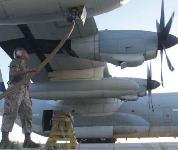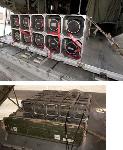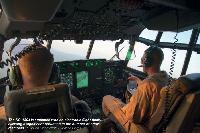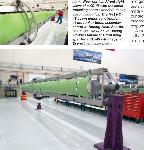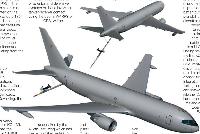Фотографии
-
Регистрационный номер: T-264 [4] T-264 refuels an F-16AM from 311 Squadron over northern Afghanistan in November 2004, while deployed to Manas AB in Kyrgyzstan.
Самолёты на фотографии: General Dynamics F-16A/C/E Fighting Falcon - США - 1974McDonnell Douglas KC-10 Extender - США - 1981
-
Регистрационный номер: T-264 [4] KDC-10s are used to air refuel fighters on deployment, and have supported trans-Atlantic deliveries of surplus RNLAF F-16AMs sold to Chile, including these examples in August 2011.
Самолёты на фотографии: General Dynamics F-16A/C/E Fighting Falcon - США - 1974McDonnell Douglas KC-10 Extender - США - 1981
-
Регистрационный номер: T-235 [3] T-235, the oldest KDC-10, was built in 1976 and had flown over 80,600 hours by mid-2013.
Самолёты на фотографии: McDonnell Douglas KC-10 Extender - США - 1981
-
Самолёты на фотографии: McDonnell Douglas KC-10 Extender - США - 1981
-
Регистрационный номер: T-235 [3] The KDC-10 has a maximum take-off weight of 565,000 lb, including up to 245,566 lb of fuel.
Самолёты на фотографии: McDonnell Douglas KC-10 Extender - США - 1981
-
Регистрационный номер: T-264 [4] T-264 seen at Eindhoven as the fog clears on a winter morning.
Самолёты на фотографии: McDonnell Douglas KC-10 Extender - США - 1981
-
The aerial refuelling boom fitted to the KDC-10 can extend to a maximum length of 15m (49ft).
Самолёты на фотографии: McDonnell Douglas KC-10 Extender - США - 1981
-
The pilot director lights underneath the fuselage indicate the movement required to correctly position the receiver aircraft for contact with the boom.
Самолёты на фотографии: McDonnell Douglas KC-10 Extender - США - 1981
-
A fairing under the aft fuselage houses the five TRVS cameras.
Самолёты на фотографии: McDonnell Douglas KC-10 Extender - США - 1981
-
Регистрационный номер: T-235 [3] RNLAF personnel board KDC-10 Jan Scheffer for their flight to Afghanistan.
Самолёты на фотографии: McDonnell Douglas KC-10 Extender - США - 1981
-
The KDC-10s and DC-10 operated by 334 Squadron are the largest aircraft in RNLAF service.
Самолёты на фотографии: McDonnell Douglas KC-10 Extender - США - 1981
-
The KDC-10 flight deck now features multi-functional displays following the recent cockpit upgrade.
Самолёты на фотографии: McDonnell Douglas KC-10 Extender - США - 1981
-
Регистрационный номер: T-264 [4] The analogue flight deck of T-264, seen in April 2012 prior to its upgrade.
Самолёты на фотографии: McDonnell Douglas KC-10 Extender - США - 1981
-
The RARO station is located immediately behind the cockpit, from where the boom is operated by the boomer with joysticks.
Using special 3D glasses, the boom operator in the KDC-10's remote air refuelling operator station controls the boom while refuelling an RNLAF F-16AM during Frisian Flag.Самолёты на фотографии: McDonnell Douglas KC-10 Extender - США - 1981
-
Unlike the KDC-10s, 334 Squadron's DC-10-30CF does not have a passenger compartment in its spacious cabin.
Самолёты на фотографии: McDonnell Douglas KC-10 Extender - США - 1981
-
A French Air Force Mirage 2000-5 refuelling from a KC-130J.
Самолёты на фотографии: Dassault Mirage 2000 - Франция - 1978Lockheed C-130J Super Hercules - США - 1996
-
Самолёты на фотографии: Lockheed C-130J Super Hercules - США - 1996Sikorsky UH-60 Black Hawk / S-70 - США - 1974
-
No.10 Squadron commenced regular North Sea tow line operations with Tornado GR4s in May 2013.
Самолёты на фотографии: Airbus A330 MRTT / KC-30 Voyager - International - 2007Panavia Tornado IDS (GR) - International - 1974
-
Регистрационный номер: ZZ331 [3], EC-331 [3] Самолёты на фотографии: Airbus A330 MRTT / KC-30 Voyager - International - 2007Eurofighter Typhoon / EF-2000 - International - 1994Panavia Tornado IDS (GR) - International - 1974
-
Регистрационный номер: ZJ934 Самолёты на фотографии: Airbus A330 MRTT / KC-30 Voyager - International - 2007Eurofighter Typhoon / EF-2000 - International - 1994
-
Voyager’s release to service for air refuelling the Typhoon was issued in August 2013.
Самолёты на фотографии: Airbus A330 MRTT / KC-30 Voyager - International - 2007Eurofighter Typhoon / EF-2000 - International - 1994
-
Регистрационный номер: ZZ331 [3], EC-331 [3] Самолёты на фотографии: Airbus A330 MRTT / KC-30 Voyager - International - 2007
-
Регистрационный номер: ZZ331 [3], EC-331 [3] Самолёты на фотографии: Airbus A330 MRTT / KC-30 Voyager - International - 2007
-
Top: Voyager’s camera system improves the situational awareness for the mission systems operator.
Middle and bottom: The Cobham 805E FRU can dispense fuel at a rate of 1,800kg/min, and installed on Voyager KC3s to refuel large receiver aircraft.Самолёты на фотографии: Airbus A330 MRTT / KC-30 Voyager - International - 2007
-
A pilot's view of the Sargent Fletcher hose and drogue extended from a 905E wing air refuelling pod.
Самолёты на фотографии: Airbus A330 MRTT / KC-30 Voyager - International - 2007
-
Two views of the 905E wing air refuelling pod.
Самолёты на фотографии: Airbus A330 MRTT / KC-30 Voyager - International - 2007
-
A Voyager KC2 parked on the flight line at RAF Brize Norton during a snowy day in January 2013.
Самолёты на фотографии: Airbus A330 MRTT / KC-30 Voyager - International - 2007
-
Voyager is available to the RAF around the clock. In August 2013, No.10 Squadron held UK Quick Reaction Alert for the first time.
Самолёты на фотографии: Airbus A330 MRTT / KC-30 Voyager - International - 2007
-
Voyager’s flight deck and glass cockpit.
Самолёты на фотографии: Airbus A330 MRTT / KC-30 Voyager - International - 2007
-
An F/A-18E Hornet taking fuel from the port drogue unit deployed by a KC-130J. Tactical refuelling operations are only one aspect of Marine KC-130J operations.
Самолёты на фотографии: Lockheed C-130J Super Hercules - США - 1996McDonnell Douglas F/A-18E Super Hornet - США - 1995
-
AGM-114 Hellfire air-to-surface missiles hanging under the wing of a Marine Corps KC-130J Hercules, already adorned with an impressive scoreboard of strikes on its front fuselage.
Самолёты на фотографии: Lockheed C-130J Super Hercules - США - 1996
-
A KC-130J of VMGR-252 equipped for the air-to-air refuelling role with both outboard pods.
Самолёты на фотографии: Lockheed C-130J Super Hercules - США - 1996
-
The HC-130J Combat King II is an integral part of the US Air Force's personnel recovery mission, providing airborne command and control and support to rescue forces, as well as refuelling the rescue helicopters so they can reach the area of operations.
Самолёты на фотографии: Lockheed C-130J Super Hercules - США - 1996
-
An armourer makes the final preparations to four ACM-114 Hellfire missiles mounted on a weapons station. The addition of air-to-surface weapons greatly increased the KC-130J's flexibility, increasing the number of options available to support troops on the ground.
Самолёты на фотографии: Lockheed C-130J Super Hercules - США - 1996
-
An AN/AAQ-30 Target Sight System, designed for the AH-1Z Viper, can be mounted on the rear of a KC-130J’s external fuel tank to allow the aircraft to undertake surveillance and designation of targets.
Самолёты на фотографии: Lockheed C-130J Super Hercules - США - 1996
-
The US Marines have 45 KC-130Js in service, with three more on order.
Самолёты на фотографии: Lockheed C-130J Super Hercules - США - 1996
-
Refuelling the refueller - topping up the tanks of a KC-130J Hercules.
Самолёты на фотографии: Lockheed C-130J Super Hercules - США - 1996
-
The Raytheon AGM-176 Griffin was designed with a small warhead for irregular warfare, including strikes in urban areas. Containers with ten missiles are attached to the rear ramp of the KC-130J Harvest Hawk.
Самолёты на фотографии: Lockheed C-130J Super Hercules - США - 1996
-
The flight deck of the MC-130J has a glass cockpit featuring five large multifunctional colour displays.
Like all members of the C-130J family, the HC-130J has a digital cockpit with five primary displays, all NVG compatible.Самолёты на фотографии: Lockheed C-130J Super Hercules - США - 1996
-
The KC-130J is equipped with an electronic flight deck, allowing a significant reduction in the number of crew members.
Самолёты на фотографии: Lockheed C-130J Super Hercules - США - 1996
-
The modular Harvest Hawk control station installed inside a KC-130J Hercules.
Самолёты на фотографии: Lockheed C-130J Super Hercules - США - 1996
-
Sargent Fletcher/Cobham 48” Series Wing Air Refueling Pod
Самолёты на фотографии: Lockheed C-130J Super Hercules - США - 1996
-
The first KC-46 boom under construction at the tanker boom assembly center at Boeing Field, Seattle.
Самолёты на фотографии: Boeing KC-767 / KC-46 Pegasus - США - 2005
-
On June 26, 2013 Boeing workers loaded the first wing spar for a KC-46 into the jig at Everett.
Самолёты на фотографии: Boeing KC-767 / KC-46 Pegasus - США - 2005
-
Boeing KC-46A ... costs exceeded
Самолёты на фотографии: Boeing KC-767 / KC-46 Pegasus - США - 2005
-
Самолёты на фотографии: Boeing KC-767 / KC-46 Pegasus - США - 2005
-
Rear-right and front-right views of a KC-46 with the aerial refuelling boom extended.
Самолёты на фотографии: Boeing KC-767 / KC-46 Pegasus - США - 2005
-
Side & plan view of the KC-46
Самолёты на фотографии: Boeing KC-767 / KC-46 Pegasus - США - 2005









